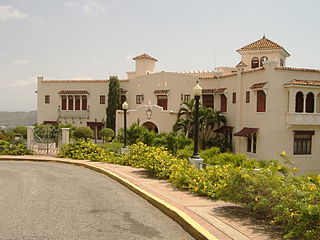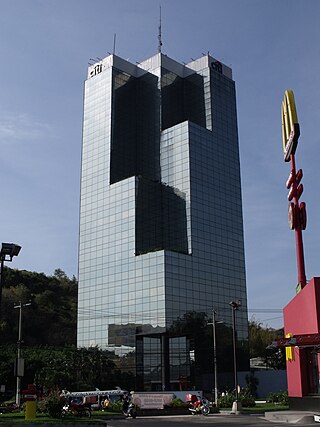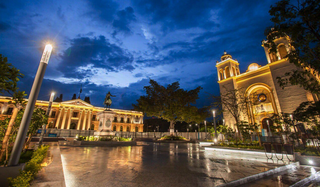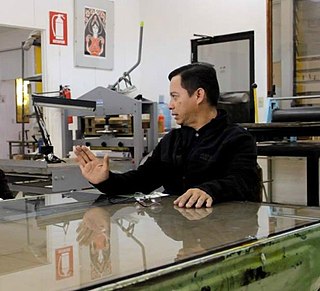
This is a demography of the population of El Salvador including population density, ethnicity, education level, health of the populace, economic status, religious affiliations and other aspects of the population.

San Salvador is the capital and the largest city of El Salvador and its eponymous department. It is the country's political, cultural, educational and financial center. The Municipality of San Salvador has 209,633 inhabitants (2020). The Metropolitan Area of San Salvador, which comprises the capital itself and 13 of its municipalities, has a population of 2,404,097. The urban area of San Salvador has a population of 1,600,000 inhabitants.

The Castle of Púbol or Gala Dalí Castle House-Museum, located in Púbol in the comarca of Baix Empordà, Girona, Catalonia, Spain, is a medieval building where the surrealist painter Salvador Dalí's enormous creative efforts were focused on a single person, his wife Gala, with the aim of providing her with a unique sanctuary and resting place. Gala is buried at the castle. Together with the Salvador Dalí House Museum in Portlligat and the Dalí Theater-Museum in Figueres, they form the Empordà Dalinian triangle.

Casa Presidencial, or "Presidential House" in the Spanish language, is the President of El Salvador's official residence and his offices.

Chapultepec Castle is located on top of Chapultepec Hill in Mexico City's Chapultepec park. The name Chapultepec is the Nahuatl word chapoltepēc which means "on the hill of the grasshopper". It is located at the entrance to Chapultepec park, at a height of 2,325 metres (7,628 ft) above sea level. The site of the hill was a sacred place for Aztecs, and the buildings atop it have served several purposes during its history, including serving as a military academy, imperial residence, presidential residence, observatory, and since February 1939, the National Museum of History. Chapultepec Castle, along with Iturbide Palace, also in Mexico City, are the only royal palaces in North America which were inhabited by monarchs.

Castillo Serrallés is a mansion located in the city of Ponce, Puerto Rico, overlooking the downtown area. It was built during the 1930s for Juan Eugenio Serrallés, son of businessman Juan Serrallés, founder of Destilería Serrallés. The structure sits on a 2.5-acre (1.0 ha) exceedingly manicured property. Nowadays, the structure functions as a museum, Museo Castillo Serrallés, with information about the sugar cane and rum industries and its impact in the economy of Puerto Rico. It is also increasingly used as a venue for social activities, including destination weddings. The property was listed in the National Register of Historic Places in 1980. In 1996, the structure was featured in the American TV series America's Castles.

José Simeón Cañas Central American University, also known as UCA El Salvador, is a private Catholic university with nonprofit purposes in San Salvador, El Salvador. It is operated by the Society of Jesus.

The Iglesia de Nuestra Señora del Carmen is a catholic parish church in the city of Santa Tecla, La Libertad Department, El Salvador. It was completed in 1914 in a neo-gothic style.

Claudia Lars, born in Armenia, El Salvador on December 20, 1899 as Margarita del Carmen Brannon Vega, was a Salvadoran poet. She died in San Salvador in 1974. She was the daughter of Peter Patrick Brannon and Carmen Vega Zelayandía.

Licenciado José Damián Villacorta Cañas was a Salvadoran lawyer and politician. He was chief of state of El Salvador from February 16, 1830, to December 4, 1830, while it was a state within the Federal Republic of Central America.

Francisco Antonio Gavidia Guandique was a prominent Salvadoran writer, historian, politician, speaker, translator, educator and journalist. His poetry evolved from romanticism to a reflective direction and conceptual character. He was greatly influenced by French poetry of the time and he introduced Rubén Darío to adapt the Alexandrian verse to the Castilian metre in addition to entering the story, poetry and essays. The trajectory of his poetry is similar to the one of his theater, as he demonstrates in his dramas Jupiter (1885), Ursino (1889), Count of San Salvador or the God of the things (1901), Lucia Lasso or the Pirates (1914) and the Ivory Tower (1920), and the dramatic poem Princess Catalá (1944).

Torre Cuscatlán is an office building and is one of the tallest buildings in El Salvador located in the capital city San Salvador. Finished in 1989, it is 79 meters high and has 19 floors. Ricardo Jiménez Castillo, who is considered one of the most representative architects of El Salvador, was in charge of the building's design. It is influenced by modern style, using a complete glass cladding for the exterior. The main characteristic of its design is the 3 setbacks covered with plants that run along with the height of the building. The materials used to construct the tower were aluminum, reinforced concrete, and glass. The building was the tallest in El Salvador from 1989 to 2009 when the Torre Cuscatlán lost the title to the Tower Pedregal. As of 2022, It is currently the 3rd tallest building in El Salvador.

Salvadorans, also known as Salvadorians, are citizens of El Salvador, a country in Central America. Most Salvadorans live in El Salvador, although there is also a significant Salvadoran diaspora, particularly in the United States, with smaller communities in other countries around the world.
Julio Enrique Martínez Rivera is a retired Salvadoran footballer who last played for Águila and internationally for the El Salvador national team.

The National Museum of Decorative Arts is an art museum in Recoleta, Buenos Aires, Argentina.

During the Salvadoran Civil War, on 16 November 1989, Salvadoran Army soldiers killed six Jesuits and two others, the caretaker's wife and daughter, at their residence on the campus of Central American University in San Salvador, El Salvador. Polaroid photos of the Jesuits' bullet-riddled bodies were on display in the hallway outside the Chapel, and a memorial rose garden was planted beside the chapel to commemorate the murders.

The San Salvador historic downtown includes the area where the capital city of El Salvador has been located since the 16th century. This district has long been the country's political, economic and religious center.

Román Mayorga Rivas was a Nicaraguan journalist and poet. He is considered the founder of modern journalism in El Salvador.

Giovanni Gil, also known as Hector Giovanni Gil Portillo is a plastic artist and one of the greatest exhibitors of Engraving in El Salvador. He is the founder and director of the projects Soñar al Revés [Dreaming Backwards] and Bajo Presión [Under Pressure] and is the winner of the Silver Medal at the Salon of Contemporary Art El Salvador-



















